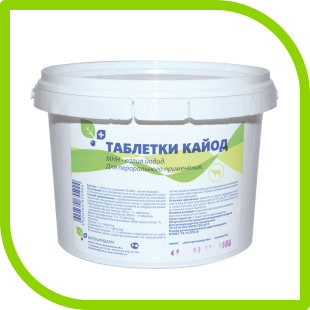
INSTRUCTIONS
of using Kayod tabs
(Organization – developer: “BioKhimPharm”, Raduzhny, Vladimir region).
1. GENERAL INFORMATION
1 Tablets “Kayod” (Tabulettae “Caiodum”).
2 The drug is a flat white tablets of a circular shape with a transverse risk.
Each tablet contains 0.006 g of potassium iodide.
3 The drug is produced in plastic bags and polymer package for 830 pcs. (250 g), 1665 pcs. (500 g) and 3330 pcs. (1 kg).
4 The drug is stored with caution (under list B) in a dry, dark place at a temperature of plus 5 to plus 25 ° C.
5. Shelf life 2 (two) years from the date of manufacture, subject to the storage rules.
2 PHARMACOLOGICAL PROPERTIES
6. Iodine participates in the metabolism of animals as part of the hormone of the thyroid gland, promotes fermentation, supports the protective reactions of the body, accelerates the formation of new cells, favorably affects the development of the fetus.
7. The use of the drug contributes to the prevention and treatment of enzootic goiter and other diseases associated with iodine deficiency, which leads to an increase in the productivity and safety of animals.
8. Tablets “Kayod” do not contain free iodine, and, therefore, do not act irritatingly on the mucous membrane of the gastrointestinal tract. Potassium iodide is well absorbed and changes with formation of iodine; while iodides act resorptively in the same way as iodine. Iodine is released in small amounts through the kidneys, sebaceous, sweaty, bronchial and salivary glands, milk.
3 PREPARATION OF THE PREPARATION
9. Kayod tablets are used for cattle for the prevention and treatment of iodine deficiency and diseases developing against this background.
10. With the preventive purpose, the drug is administered to the animals daily orally in areas with insufficient iodine content in soils and forages in the following doses:
Cattle fattening fattening:
– young animals weighing up to 300 kg – ½ tablets;
– young animals weighing more than 300 kg – 1 tablet.
Adult animals: 1½ – 2 tablets.
Bulls-producers (for every 200 kg of body weight): ½ tablets.
Bethes: ½ – 1 tablet.
Primary: 1 – 1 ½ tablets.
Dairy cows (table 1):
Table 1
|
Dose, l |
Dose of the drug per cow per day, tablets |
|||
|
From the 3rd month of lactation to dryness |
During the period of deadliness |
First month of lactation |
Second month of lactation |
|
|
2000-3000 |
½ – 1 |
½ – 1 |
1 – 1 ½ |
1 – 1 ½ |
|
3000-4000 |
1 – 1 ½ |
1 – 1 ½ |
1 ½ – 2 |
1 ½ – 2 |
|
4000-5000 |
1 ½ – 2 |
1 ½ – 2 |
2 – 2 ½ |
2 – 2 ½ |
|
5000-6000 |
2 – 2 ½ |
2 – 2 ½ |
2 ½ – 3 |
2 ½ – 3 |
For medicinal purposes, the drug is prescribed according to the indications in the same doses and gives up the disappearance of the clinical signs of the disease.
11. When used in recommended amounts, side effects and complications are not noted.
Contraindications: nephritis, nephrosis, furunculosis, urticaria, chronic pyoderma, adenomas (including thyroid gland), hemorrhagic diathesis.
When the drug is overdosed, colic, vomiting, diarrhea, sometimes bloody, weakening of the heart, degenerative changes in the internal organs, fever. When poisoning with iodine, use mucous broths, milk, egg white, inside – sodium thiosulfate, activated charcoal and additionally symptomatic means.
12. Pharmaceutical preparation is incompatible with essential oils, derivatives of ammonia; weakens the hypothyroid and strugogenic effects of lithium preparations.
13. Products from animals after application of the drug can be used without restrictions.
4 PERSONAL PROTECTION MEASURES
14. When working with the drug, you should follow the rules of personal hygiene and safety.
15. Do not use the medicine package for household purposes.
16. The drug should be stored in a place inaccessible to children.
5 The procedure for the presentation of complaints
17. In the event of complications after the use of the drug, its use is terminated and the consumer applies to the State Veterinary Institution in whose territory he is located.
Veterinary specialists of this institution make a study of compliance with all rules for the use of the drug in accordance with the instructions. When confirming the ineffectiveness or lack of conformity of the remedy in appearance, veterinarians select samples in the required quantity for laboratory tests, compile a sampling report and be sent to the State Institution “Belarusian State Veterinary Center” (Minsk, Krasnaya str., 19a) for confirmation of compliance of the drug regulatory documentation.








